Most previous work on racial disparities has studied inequality within a single generation of people. In a new study, we analyse how racial gaps change across generations. Using de-identified data covering 20 million children and their parents, we show how race currently shapes opportunity in the US and how we can reduce racial disparities going forward.
Mobility across five racial and ethnic groups
We study five racial and ethnic groups: people of Hispanic ethnicity and non-Hispanic whites, blacks, Asians, and American Indians. By analysing rates of upward and downward mobility across generations for these groups, we quantify how their incomes change and predict their future earnings trajectories.
Hispanic Americans have rates of upward income mobility across generations that are slightly below those of whites. Hispanics are therefore on a path to moving up substantially in the income distribution across generations, potentially closing much of the present gap between their incomes and those of white Americans.
Asian immigrants have much higher levels of upward mobility than all other groups, but Asian children whose parents were born in the US have levels of intergenerational mobility similar to white children. This makes it more difficult to predict the trajectory of Asian Americans’ incomes, but Asians appear likely to remain at income levels comparable to or above white Americans in the long run.
In contrast, black and American Indian children have substantially lower rates of upward mobility than the other racial groups. For example, black children born to parents in the bottom household income quintile have a 2.5% chance of rising to the top quintile of household income, compared with 10.6% for whites.
Children’s incomes vs. parents’ incomes, by race and ethnicity
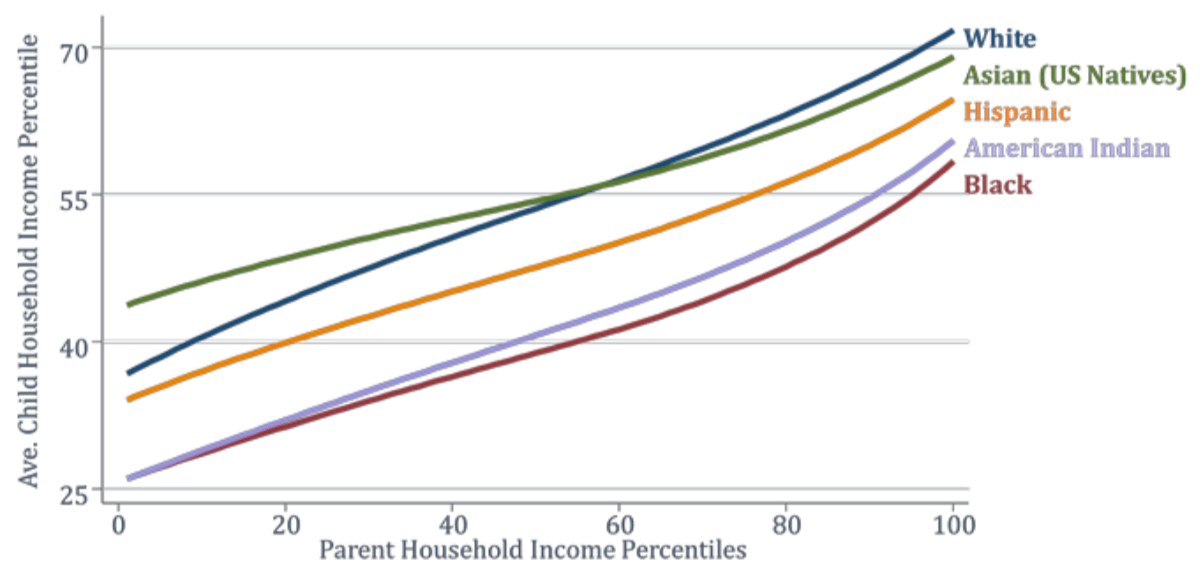
Growing up in a high-income family provides no insulation from these disparities. American Indian and black children have much higher rates of downward mobility than other groups. Black children born to parents in the top income quintile are almost as likely to fall to the bottom quintile as they are to remain in the top quintile. By contrast, white children born in the top quintile are nearly five times as likely to stay there as they are to fall to the bottom.
Because of these differences in economic mobility, blacks and American Indians are “stuck in place” across generations. Their positions in the income distribution are unlikely to change without efforts to increase their rates of upward mobility.
Changes in income across generations, by racial group
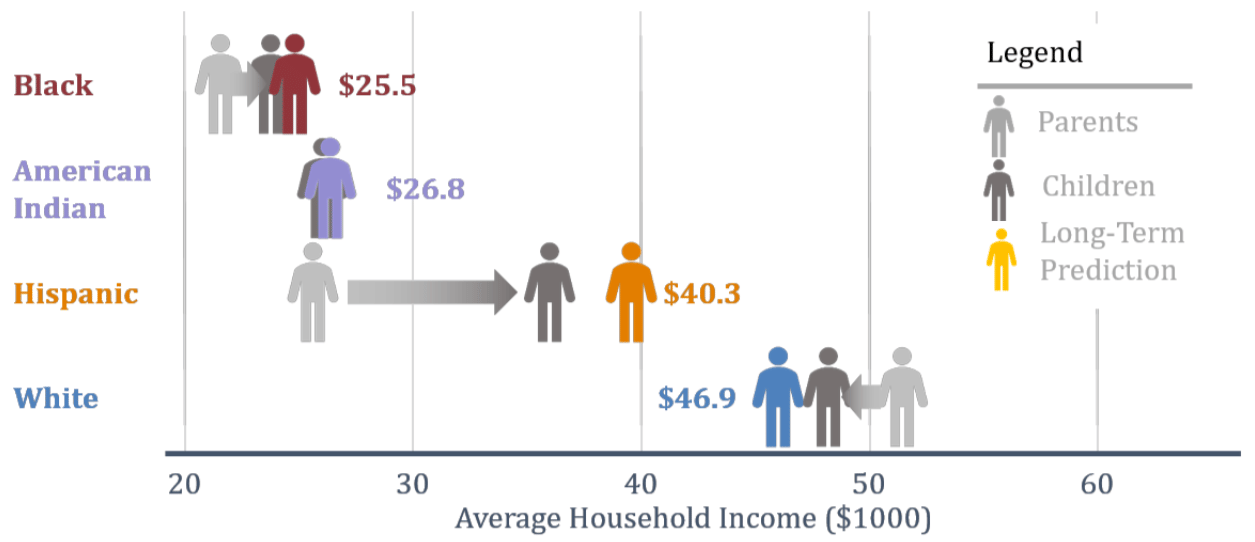
Also read: On Slave Trade Remembrance Day, a look at how world has confronted legacy of slavery, racism
The black-white income gap
Among those who grow up in families with comparable incomes, black men grow up to earn substantially less than the white men. In contrast, black women earn slightly more than white women conditional on parent income. Moreover, there is little or no gap in wage rates or hours of work between black and white women.
Children’s incomes vs. parents’ incomes, for black and white men and women
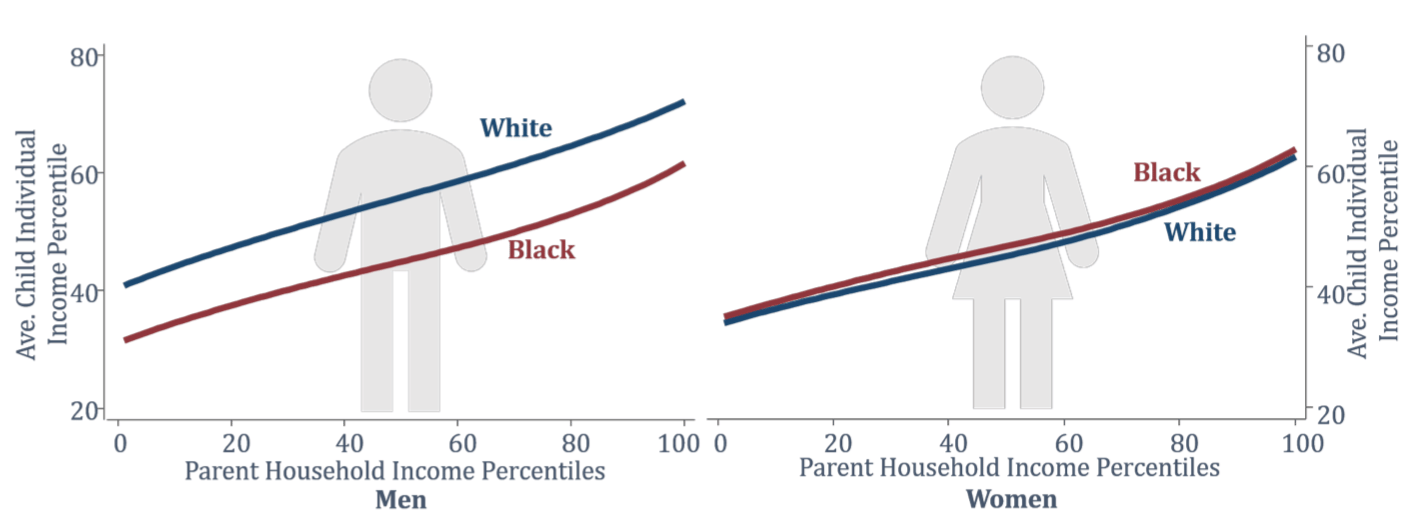
We find analogous gender differences in other outcomes: black-white gaps in high-school completion rates, college attendance rates, and incarceration are all substantially larger for men than for women. Black women have higher college attendance rates than white men, conditional on parental income. For men, the gap in incarceration is particularly stark: 21% of black men born to the lowest-income families are incarcerated on a given day, far higher than for any other subgroup.
Differences in family characteristics and ability
Black children are much more likely to grow up in single parent households with less wealth and parents with lower levels of education – all factors that have received attention as potential explanations for black-white disparities. But, when we compare the outcomes of black and white men who grow up in two-parent families with similar levels of income, wealth, and education, we continue to find that the black men still have substantially lower incomes in adulthood. Hence, differences in these family characteristics play a limited role in explaining the gap.
Perhaps most controversially, some have proposed that racial disparities might be due to differences in innate ability. This hypothesis does not explain why there are black-white intergenerational gaps for men but not women. Moreover, black-white gaps in test scores – which have been the basis for most prior arguments for ability differences – are substantial for both men and women. The fact that black women have outcomes comparable to white women conditional on parental income despite having much lower test scores suggests that standardised tests do not provide accurate measures of differences in ability (insofar as it is relevant for earnings) by race, perhaps because of stereotype anxiety or racial biases in tests.
Also read: Black Lives Matter must fire up India’s anti-caste movement to fight its central villain
The neighbourhood effect
One of the most prominent theories for why black and white children have different outcomes is that black children grow up in different neighbourhoods than whites. But, we find large gaps even between black and white men who grow up in families with comparable income in the same Census tract (small geographic areas that contain about 4,250 people on average). Indeed, the disparities persist even among children who grow up on the same block. These results reveal that differences in neighbourhood-level resources, such as the quality of schools, cannot explain the intergenerational gaps between black and white boys by themselves.
Black-white disparities exist in virtually all regions and neighbourhoods. Some of the best metro areas for economic mobility for low-income black boys are comparable to the worst metro areas for low-income white boys. And black boys have lower rates of upward mobility than white boys in 99% of Census tracts in the country.
Average incomes for black and white men who grow up in low-income (25th percentile) families
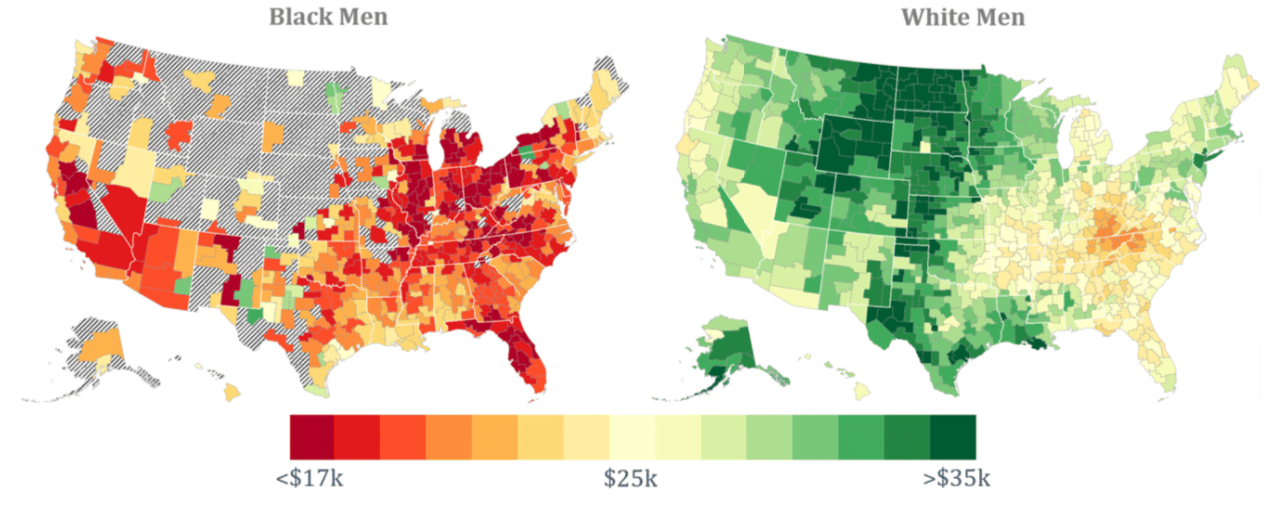
Mobility rates in low-poverty areas
Areas that have higher rates of upward mobility for whites tend to have higher rates of upward mobility for blacks as well. For both blacks and whites, upward mobility is highest for children who grow up in the Great Plains and the coasts and lowest in the cities in the industrial Midwest. One notable exception to this pattern is the Southeast, where whites have especially low rates of upward mobility (relative to other whites nationwide) but blacks do not.
Both black and white boys have better outcomes in neighbourhoods commonly perceived to be “good” areas: Census tracts with low poverty rates, high test scores, and a large fraction of college graduates. However, black-white gaps are larger on average for boys who grow up in such tracts, because whites benefit more from living in such areas than blacks do.
Also read: Four ways to be an ally in the fight against racism
Impact of racial bias in low-poverty areas
In low-poverty neighbourhoods, two types of factors are most strongly associated with better outcomes for black men and smaller black-white gaps: low levels of racial bias among whites and high rates of father presence among blacks.
Black men who grow up in tracts with less racial bias among whites — measured by testing for implicit bias or explicit racial animus in Google searches — earn more and are less likely to be incarcerated.
Higher rates of father presence among low-income black households are associated with better outcomes for black boys, but are uncorrelated with the outcomes of black girls and white boys. Black father presence at the neighbourhood level predicts black boys’ outcomes irrespective of whether their own father is present or not, suggesting that what matters is not parental marital status itself, but rather community-level factors associated with the presence of fathers, such as role-model effects or changes in social norms.
The black-white gap is not immutable
Black men who move to better areas – such as those with low poverty rates, low racial bias, and higher father presence – earlier in their childhood have higher incomes and lower rates of incarceration as adults. These findings show that environmental conditions during childhood have causal effects on racial disparities, demonstrating that the black-white income gap is not immutable.
The challenge is that very few black children currently grow up in environments that foster upward mobility. Fewer than 5% of black children currently grow up in areas with a poverty rate below 10% and more than half of black fathers present. In contrast, 63% of white children grow up in areas with analogous conditions.
Also read: Oprah Winfrey sent a book on caste to 100 US CEOs but Indians still won’t talk about it
Implications
Our results show that the black-white gap in upward mobility is driven primarily by environmental factors that can be changed. But, the findings also highlight the challenges in addressing these environmental disparities. Black and white boys have very different outcomes even if they grow up in two-parent families with comparable incomes, education, and wealth, live on the same city block, and attend the same school. This finding suggests that many widely discussed proposals may be insufficient to narrow the black-white gap themselves, and suggests potentially new directions to consider.
For instance, policies focused on improving the economic outcomes of a single generation – such as temporary cash transfers, minimum wage increases, or universal basic income programmes – can help narrow racial gaps at a given point in time. However, they are less likely to narrow racial disparities in the long run, unless they also change rates of upward mobility across generations. Policies that reduce residential segregation or enable black and white children to attend the same schools without achieving racial integration within neighbourhoods and schools would also likely leave much of the gap in place.
Initiatives whose impacts cross neighbourhood and class lines and increase upward mobility specifically for black men hold the greatest promise of narrowing the black-white gap. There are many promising examples of such efforts: mentoring programmes for black boys, efforts to reduce racial bias among whites, interventions to reduce discrimination in criminal justice, and efforts to facilitate greater interaction across racial groups. We view the development and evaluation of such efforts as a valuable path forward to reducing racial gaps in upward mobility.
Raj Chetty and Nathaniel Hendren are professors of economics at Harvard University. Economist Maggie R. Jones and researcher Sonya R. Porter are with the US Census Bureau.
This is an edited summary of the authors’ paper Race and Economic Opportunity in the United States: An Intergenerational Perspective, first published by Opportunity Insights, an institute based at Harvard University. Read the full paper here.



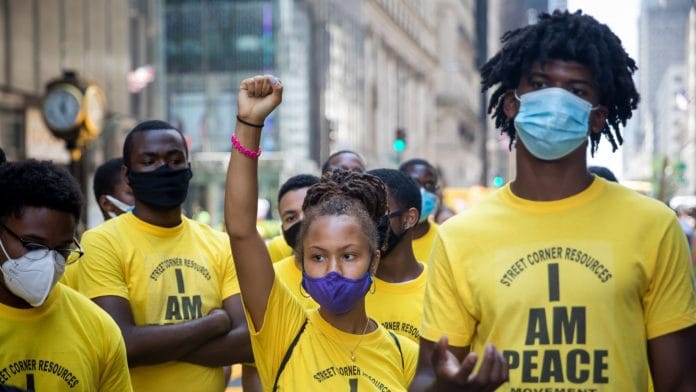



Well, the US Govt is trying its best to make it easier for Blacks to be upwardly mobile. But the majority White does not give the most important ingredient for upward mobility-360 degree ACCEPTANCE. It will remain this way even for the Asian Americans in the US. All Asian American CEOs are nominated by a few at the top and it is mostly a high tech routine. A wider acceptance??? I doubt it. You can legislate tolerance but not acceptance any where. This is true in India too with its localized prejudices. An issue unlikely to be resolved in my lifetime at least.